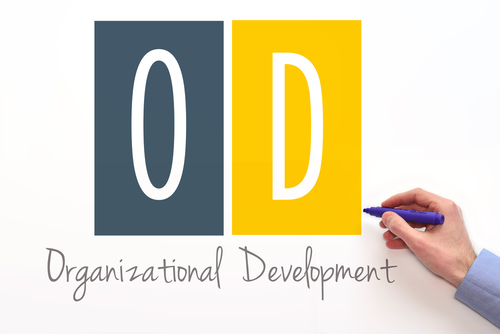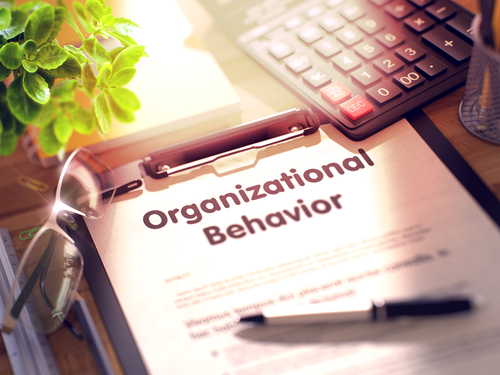
Organizational development theory is dedicated to expanding the working knowledge of individuals to enhance and to make more effective organizational performance and change. In order to command a clear understanding of this theory, it is vital to understand its essential elements. These include the objectives and core values of org development theory. It also means understanding the essentials of an organization’s cultural elements.
Five Essential Cultural Elements of an Organization

The theory of organizational developed recognizes five essential cultural elements that exist in an organization, according to the University of Pennsylvania. These are deeply seeded norms that members of a particular organization accept and share. These five essential cultural organizational elements are:
- Assumptions
- Values
- Behavioral Norms
- Behavioral Patterns
- Artifacts
One way to look at this is through anthropology or its daughter discipline, sociology. Assumptions carry the weight of fact and help shape the recognition of the known world as humans relate to it. The reason this is important in Organizational Development Theory is that nothing is static. If changes need to be made in order to reflect the known world, this is the place to begin. Commonly held assumptions, when uninformed, can lead to gross displays of disenfranchisement, inequality, and ableism. Therefore, it’s important to keep a finger to the pulse of any organizational culture, and introduce new information as needed.
The values are shared standards outlined in a mission statement. Usually, the values are clearly delineated, but even when they are assumed, there are strong markers of what they are in practice. By investigating this area, in which values are espoused and then acted upon, one can see dislocations if there are any. Values are continuously molded by actions, from both the bottom up and from the top down, making it a fruitful area in which to find discrepancies between the two. For example, if a value is one of inclusion, but the hiring practices unilaterally offer candidates from one subsection of society, there may be room for changes in practice.
That leads to the combined areas of behavioral norms and patterns. By looking here, one sees the repetition of larger cultural norms and patterns iterated within the company. It is here that change-making does its largest work. By adhering to a value system and ensuring that it is followed, one may act as a change within the larger culture.
Artifacts are, whether digital or tangible, created within a company. They are iterated through language, used to symbolize other, larger areas of discourse. For example, the theme of cubicles became so entrenched in the corporate sphere that it could be understood by others not within a particular company. This led to a movement, somewhat less than effective, of removing those barriers, and creating an open space workplace. But the artifacts go beyond this—they are the common-use items associated with any company, and the means by which these companies convey their purpose, their values, and their branding.
Core Values of Organizational Development Theory
Six core values are associated with organizational development theory. These are defined as being humanistic values. This means these core values of this theory focus on humans or individuals as opposed to mechanical processes and procedures. The core values of org com development are:
- Provide opportunities for individuals to function as individual human beings.
- Provide opportunities for an individual to develop his or her full potential.
- Seek an increase in the overall effectiveness of an organization.
- Provide an opportunity for individuals to influence the manner in which they relate to an organization.
- Create an environment in which individuals have challenging work.
- Treat each individual in an organization as having important, complex needs.
These core values are essential to understand. By providing opportunities for individuals to make choices and take initiative in his or her own development, they are allowing room for novel innovations. It may seem counter to an efficiently run organization, but it is vital to imbue each individual, irrespective of rank in the company, a sense of purpose. It allows them to take ownership and pride in their job, and to work for the benefit of the organization as a whole.
Their needs are treated as important, and they feel pride in what they do, however small. It also creates an environment in which people don’t feel replaceable, as if anyone could do their job. This encourages them to seek challenges, to press against their understood boundaries, and to be a truly great employee. Ultimately, this serves one of the key values—to increase the overall effectiveness of the organization, because one does not have a horde of mindless individuals just marking time, not questioning the status quo. They want to make their job more effective because they feel like they have a place in the company. However minimal, that feeling can be leveraged to create actual change.
Objectives of Organizational Development Theory
In addition to the six core values, there are seven identified objectives commonly associated with org development theory. These can be modified, at least to some degree, to meet the unique structure and composition of an organization. These basic objectives of org development theory are:
- Increase the level of interpersonal trust among employees.
- Increase the level of satisfaction and commitment of employees.
- Confront problems.
- Manage conflict effectively.
- Increase employee collaboration and cooperation.
- Increase organizational problem-solving.
- Implement processes that will improve ongoing organizational operations.
What Sort of Careers Use Organizational Development Theory?

There are a number of individuals who use O/D Theory in their everyday work. It’s important to know how Organizational Development and Change Management differ as theories, since many companies may use them interchangeably, but truly want one or the other. Both realms are credited to the same individual, Kurt Lewin. However, they do diverge in several important ways.
Organizational Development Specialist
These individuals are responsible for planning and coordinating employee development programs. Their focus is on leadership skills and other areas of growth for individual employees that encourage retention, and they may be responsible for developing surveys and administering them, interviews, and focused leadership training sessions. They may also be responsible for keeping a record and reviewing the progress of individuals, and as such must understand performance standards, organizational policies, expectations and other types of standards.
Often, they are expected to participate in meetings with current staff and to implement orientations for new employees. While many of these individuals conduct research in order to find performance gaps and best practices, their roles also usually encompass creating pamphlets, handouts, workbooks and other materials that employees will use in the course of their daily tasks.
HR Specialists
Ordinarily, this position supports HR standards and strategies to improve performance at all levels, from the individual to the entire company. They implement tools and recommend strategies to improve effectiveness or efficiency, as well, they also study the usefulness of policies and recommend changes. Because they are non-localized, they manage projects over several locations and may also work in tandem with HR managers to implement updated policies, analyze results, or implement new programs.
Since these individuals work with new hires, they also know pedagogical principals and curriculum methods. However, because they are generalists, they must be able to make decisions and independent judgments. Occasionally, they will work with other HR practitioners to discover the best way to solve issues that arise.
Statistical Researcher
Every O/D professional needs data that has been assessed and expertly assembled to make recommended changes. Researchers gather data and apply statistical models or software designed for the field, evaluating projections for projects such as cohesion, employee engagement, and operational schemas. They then produce reports based on their findings so executives can make better decisions.
Without their input, a company might be mystified as to why seasonal turnover is high in some areas but not in others. Researchers look for factors, such as unfair leave policies or those that indicate a disconnect with the values put forth by the company, in conjunction with cultural and demographic factors.
Organizational Development Psychologist
Usually trained as Industrial/Organizational psychologists or occupational psychologists whose specialties are in analytical assessments, consulting, and business psychology, these professionals identify underlying rationales of behavior, and principals of reason which influence the processes of business and people who engage in that business. They investigate areas such as how employees engage shareholders or communicate with one another.
But their insights go beyond that. One of the biggest issues within companies is the development of skill silos. For instance, advertising, sales, and marketing departments may be uncooperative and competitive with each other, when they should all work together. They lack common ground and boundary objects—also known as common points of reference—in their day to day communication. Rather than permit them to remain antagonistic towards each other, this individual may suggest that the department heads develop a plan with common goals and procedures to change the tune of their departments.
Organizational Effectiveness Manager
These individuals must be proficient in leading large group meetings and making persuasive presentations. Using a systems-thinking, high-level approach, they also must work with human resources and business leaders to combat system-wide organizational challenges with approaches that lead to high-value, positive impacts. This might include structural redesign and helping others to understand the benefits of cross-functional team or department integration. They must also be great communicators and teachers.
Not only must they know what they know, but they should be able to impart that knowledge to business leaders. This is because they will be partners in data gathering, with business heads gathering and communicating information about work climate, employee satisfaction, workforce capacity, management sustainability, and other issues.
Learning Specialist
Corporations employ learning specialists to study and create solutions to issues or disseminate a more standardized approach to improve employee experiences, employee effectiveness, and even streamline the training processes in a positive way for all. They look at learning gaps or skill gaps, deliver positive experiences that align with a company’s values, and address challenges. As well, they will work with business leaders, management, and human resources to get a sense of the current situation and the people in play to understand the root causes of performance gaps, so they can craft a specialized plan to address them.
They may also host a large range of development and compliance training programs in various departments. Because they work primarily as consultants, corporations may higher them to implement training solutions that acknowledge differing cultural dynamics, multifaceted situations, and global variances. They may also assist in applying change management processes to a culture across an organization’s reach.
Succession Planner
These individuals help companies prepare for both expected and unexpected changes in the future. Implementing metric tracking is one of their primary goals because it creates benchmarks for the impact of operational standards, leadership goals, and specific policies. Succession planners also invest time in knowledge sharing, to see that senior employees who may be retiring soon pass on their wealth of tips, understanding of systems, and advice for newer employees. These could be in the form of technical guides, informal workshops in which the elder employee coaches the newer cadre of workers, or webinars.
They also consult with stakeholders on how best to prepare managers who are rising to executive positions. While similar positions may accord different powers to act in various locations as well as differing responsibilities, it is sometimes necessary to standardize the role descriptions. However, succession planners strive for smooth transitions with all employees, regardless of rank.
History of Organizational Development Theory

Kurt Lewin established what is known as the Research Center for Group Dynamics at MIT. Through this and other efforts, Lewin is considered to be the “founding father” of org development theory. Because of many similarities, he’s also credited as the founder of Change Management Theory. However, there are some differences that developed later on in this particular theory, and it should be treated as another discipline in its own right.
Lewin would die before he really saw his theory take root and become widely utilized and accepted. Not only has this occurred but a person is able to a doctorate degree in org development at many major universities today.
Over the course of the past decade, businesses and organizations of different types have taken to applying org development theory in regard to their own enterprises. They do so not only to benefit the organization itself but the lives of those individuals within it. This utilization of organizational development theory is expected to continue apace into the future.
Related Resources: